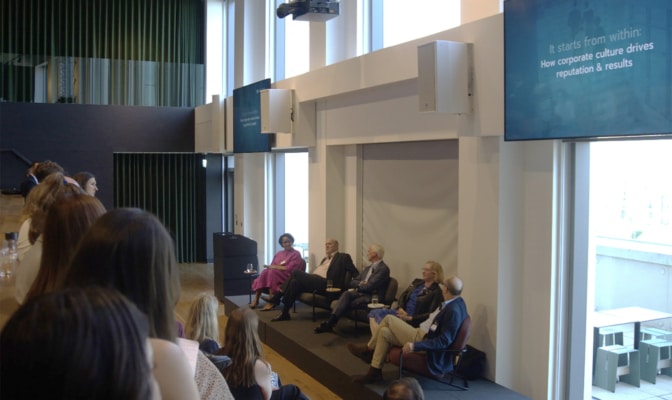H/Advisors Maitland hosted a panel discussion exploring how effective internal communications can build reputation from within and drive business success. With insights from business leaders and communications experts, the conversation delved into the importance of leadership behaviour in building trust, navigating transparency in times of uncertainty, and the role of purpose in driving culture. Special thanks to our panellists Rupert Soames OBE, Stephen Welton CBE, Jo Osborn and Martin Deboo for contributing to such a rich and thought-provoking conversation.
Key takeaways
Start with the truth – not the message you want to land
In times of uncertainty, communicating openly with employees isn’t just important – it’s an opportunity to build trust through authentic dialogue. Leaders should “start with the truth and work backwards” – rather than lead with the message they hope will land. Being open doesn’t mean saying everything – it’s sharing what you can while staying compliant with regulation. Even a simple “we don’t know yet” can be powerful when it comes from a place of honesty. Creating a culture of openness and learning – where people can raise issues and fix problems without fear of blame – helps foster a culture of trust and openness.
Leaders’ messages need to align with their behaviours
Culture is shaped – and reinforced – by the everyday actions employees observe in their leaders. When there is consistency in what leaders say and what they do, trust grows. “Culture doesn’t evolve if leadership doesn’t evolve” was a sentiment that rang true across the discussion. Leadership behaviours, combined with the organisational structures, incentives and processes that support them, are what define an organisation’s culture. For culture to stick, leaders must be consistent, intentional and visible in how they show up every day – modelling the behaviours they want others to follow.
Put your audience first
Too often, company messaging is full of jargon that is difficult for employees to connect to or translate into their day-to-day work. To communicate in a way that resonates, organisations must first listen: understand what motivates employees, challenge assumptions, and bust myths around what people really think and feel. It’s only by tuning into these insights that communicators can craft purposeful messages with the right tone of voice – cutting through the noise and connecting on a human level. The same goes for a mission statement – it needs to be clear, strategic, future-focused to resonate with employees. A strong mission offers a long-term vision of what the business is striving to be, and acts as a north star to guide decisions.
Culture and business are intertwined – and most visible under pressure
Culture is no longer a ‘soft’ topic: it’s a strategic asset and a potential risk. Yet many business leaders still struggle to make the connection between culture and results. While internal communicators often focus on clicks and engagement, what really matters to the business is whether communication drives meaningful action. Even external audiences are paying attention. Analysts are now looking at incentive frameworks, anecdotal data and even Glassdoor to build a picture of company culture and its likely impact on performance. And when the pressure’s on, culture becomes even more visible. Trust can’t be manufactured when things go wrong. It’s not about the big strategic moments; it’s the slow, day-to-day work of leadership and communication that pays off when crisis hits.






